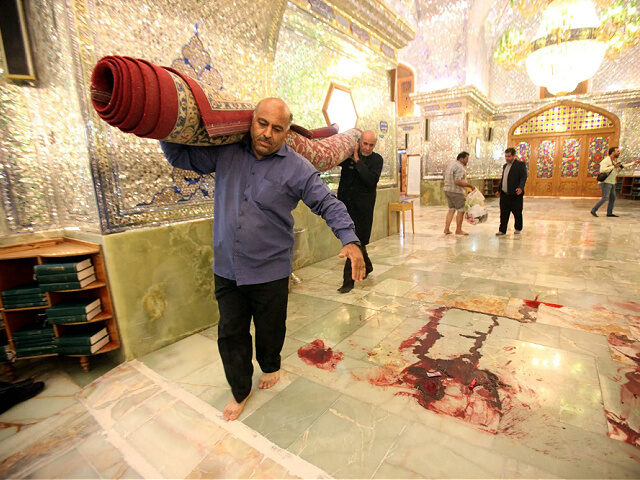Islamic State terrorists on Wednesday claimed responsibility for a gun attack on Shiite Muslim pilgrims at a shrine in the southern city of Shiraz.
The Iranian regime vowed revenge for the massacre, which killed at least 15 and wounded 19 others. The regime linked the ISIS attack to the massive protests that have swept Iran over the past two months, sparked by the killing of a young woman for allegedly violating the oppressive hijab law.
According to conflicting accounts from local media and the Iranian judiciary, between one and three gunmen opened fire during Wednesday evening prayers at the Shah Cheragh mausoleum, a mosque constructed in the 12th century that contains the tombs of two fabled Shiite martyrs. The mosque, whose name translates to “King of the Light,” is a spectacular example of architecture and a major tourist attraction, in addition to being a center of worship.
Iranian media stated the attacker or attackers entered the shrine and “fired indiscriminately on worshipers” until they were captured by police. The reports implied at least one assailant is alive, in custody, and apparently resisting interrogation efforts.
Eyewitnesses said they heard women screaming during the attack, and media photos showed the bodies of two children and a woman among the dead.
The National on Thursday provided an account of the attack based on security camera footage:
CCTV footage broadcast on state TV on Thursday showed the attacker entering the shrine after hiding an assault rifle in a bag and shooting as worshippers tried to flee and hide in corridors. The semi-official Tasnim news agency said the attacker shot an employee at the shrine entrance before his rifle jammed and he was chased by bystanders.
He managed to unjam his weapon and opened fire on his pursuers, before entering a courtyard and shooting worshippers. Women and children were among the dead, according to the agency. “I heard sounds of gunfire after we prayed,” a witness told state TV. “We went to a room next to the shrine. This lowlife came and fired a barrage of shots.
“Then [the bullet] hit my arm and leg, it hit my wife’s back, but thank God my child was not hit. He is seven years old.”
Iranian officials quickly blamed the attack on “takfiri terrorists.” Takfiri, which essentially means “fake Muslim,” is a term the Iranian government frequently uses for Sunni Muslim militants, especially those belonging to ISIS.
A message posted on the Telegram encrypted messaging platform on Thursday by an account linked to Islamic State operatives claimed responsibility for the attack. The message credited an ISIS gunman with “killing at least 20 Shias and wounding dozens of others.”
Supreme Leader Ayatollah Ali Khamenei promised a “severe response” to the attack, while President Ebrahim Raisi said the crime would “definitely not go unanswered.”
“The security and law enforcement forces will teach a lesson to those who designed and carried out the attack,” Raisi vowed.
Raisi condemned the “enemies of Iran” who use “violence and terror” to “divide the united ranks of the nation,” which is disturbingly close to how his government talks about the Mahsa Amini protests.
Wednesday was the 40th day after Amini’s death at the hands of Iranian “morality police” for allegedly violating the hijab law. Day 40 is traditionally when a death is most strongly grieved and remembered under Shiite tradition, so thousands of protesters were on the streets doing just that, particularly in the Kurdish region from which Amini hailed.
Some Iranian officials went further in linking the Shiraz massacre to the Amini uprising, including Foreign Minister Hossein Amir-Abdollahian, who said the time has come for Tehran to act against “terrorists and foreign meddlers.” The regime claims foreign powers are orchestrating the anti-hijab protests.
“This crime made the sinister intentions of the promoters of terror and violence in Iran completely clear. There is reliable information that the enemies have drawn up a multilayered project to make Iran insecure,” Abdollahian said.
Iranian police reportedly used tear gas and live ammunition to fire on protesters in Amini’s home city of Saqqez on Wednesday, after thousands of mourners held a procession to the graveyard where the 22-year-old woman was buried. The mourners chanted, “Woman, Life, Freedom,” the semi-official slogan of the Amini uprising, “Down with traitors,” “Kurdistan will be the graveyard of fascists,” and “Death to the dictator,” meaning Ayatollah Khamenei.

COMMENTS
Please let us know if you're having issues with commenting.